My Grandfather's Life
S.S. Bayeskimo & S.S. Baychimo
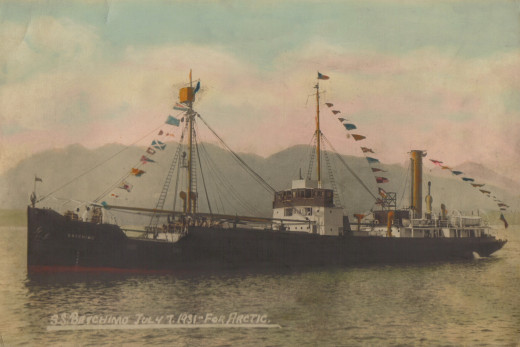 |
| Baychimo leaving Vancouver for the Arctic in July 1931, Note her distinctive, rear-mounted funnel. |
My grandfather, Harry Bolton, grew up in the town of Sunderland in north-east England. He was a marine engineer for the the Hudson's Bay Company. At that time, steamships of the company destined for the Arctic left regularly from the Ayrshire town of Ardrossan - then a thriving seaport and shipbuilding centre. So to avoid the tiresome journey each year from Sunderland to Ardrossan, my grandfather moved the family to Ardrossan in the early 1920's, taking residence in a pleasant semi-detached house not far from the flat in Saltcoats where I have lived since 2016.
During his career, my grandfather worked as chief engineer on two notable company vessels - the Bayeskimo and the Baychimo.
The 1,390 ton steamship Bayeskimo was built at Ardrossan Dockyard in 1922. The photographs below were taken in June of that year at Ardrossan Harbour during trials before her maiden voyage.
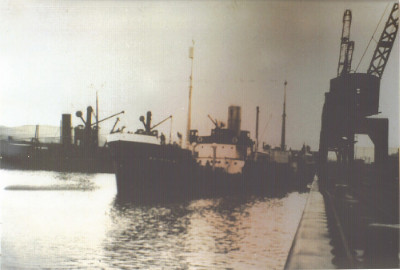 |
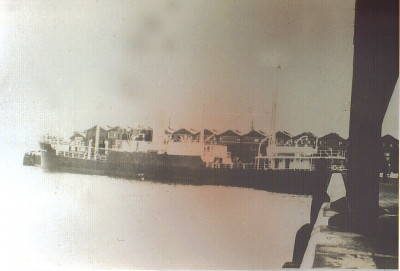 |
| Bayeskimo in Ardrossan Harbour, 1922 |
.......at Montgomerie Pier, Ardrossan Harbour |
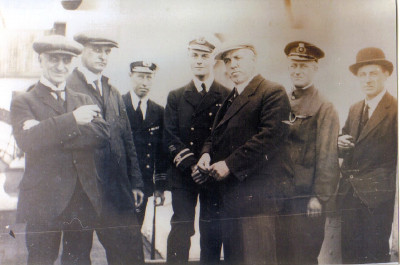 |
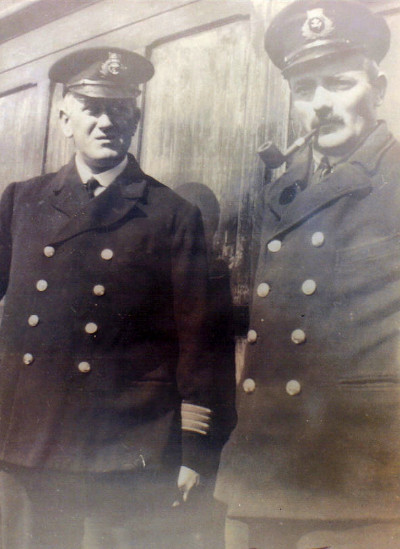 |
Hudson's Bay Co. officials and Bayeskimo crew during trials. Second officer Fred Berchem at centre; Harry Bolton,chief engineer, second from right |
Harry Bolton, with Bayeskimo's first captain, Enoch Falk |
The business of the Hudson's Bay Company was to hunt the animals of the Arctic, the sea-lions, polar bears, etc., for their furs and oils. The sailors who hunted them had to be really tough and courageous to withstand the very severe weather conditions. The voyages were always dangerous and could only be done during the short Arctic summer. During one such voyage, in July 1925, when my grandfather was chief engineer on the Bayeskimo, that ship became blocked in ice in Ungava Bay, off the Hudson Strait west of Greenland and her hull was crushed. All on board had to be rescued by another HBC vessel, the ice-breaker Nascopie:
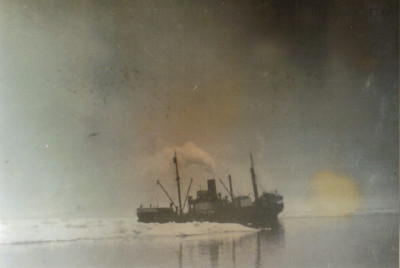 |
 |
| Bayeskimo founders in Ungava Bay, her hull crushed |
Bayeskimo's crew, with salvaged materials, awaiting rescue |
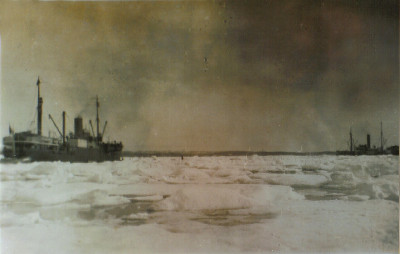 |
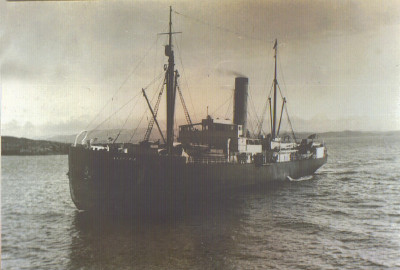 |
| Nascopie (right) arrives to rescue Bayeskimo's crew |
icebreaker Nascopie (archive photograph) |
Launched in 1915 at the Lindholmen yard in Gothenburg, the 1,300 ton steamship Angermanalfven spent her early years plying between Baltic ports in northern Germany and Sweden. She was seized by the British after the First World War as part of German post-war reparations and was renamed the Baychimo after purchase by the Hudson's Bay Company in 1921.
Baychimo regularly over-wintered in Ardrossan, and would set sail in the spring for the long voyage to north Alaska, via Panama, Vancouver and the Bering Straits. From 1923 onwards, her captain was Sydney Cornwell and, following the loss of the Bayeskimo, my grandfather became Baychimo's chief engineer.
Ghost Ship of the Arctic
The Baychimo successfully completed nine annual expeditions to the company's trading posts in northern Canada and Alaska.
Ahead of her next voyage, Baychimo spent the winter of 1930 in Vancouver. She took on supplies there and set sail for Alaska on July 7th, 1931. By the end of that month, despite some weather and technical problems, she reached the trading area on the north coast of Alaska. But winter conditions closed in early that year and by early October, Baychimo was imprisoned by pack-ice near to the village of Wainwright, west of Point Barrow and about a mile and a half from the shoreline.
When they realized that the ship was in danger of being crushed, the crew and passengers left her and crossed the frozen sea on foot to get to "dry land". In response to an S.O.S., twenty-two of them were uplifted on or after 15th October by ski-planes, a dangerous and laborious procedure as only a few men at a time could be accommodated for the six hundred mile flight to Nome in western Alaska.
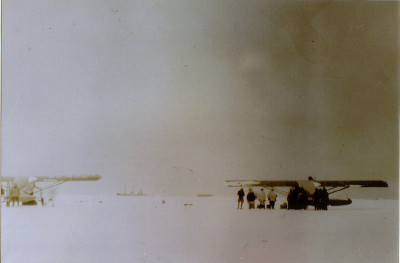 |
Ski-planes preparing to rescue the 22 passengers and crew in October 1931. In the distance, at left, Baychimo, at right the makeshift accommodation,where the remaining crew were destined to spend the winter. |
| A last view of the Baychimo for the twenty-two men rescued in October 1931. |
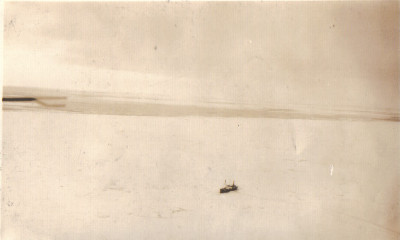 |
But Baychimo was not to be left completely on her own - not with cargo in her hold estimated to be worth 58,000 US dollars, of which 42,000 dollars was in furs. Captain Cornwell and fifteen of his crew remained close by in the frozen wastes of northern Alaska. This group included my grandfather, and four other Ardrossan men, Finlay Murchie (third engineer), M. Barr (donkeyman), James McEwan and P.McGreer (seamen). They constructed a makeshift cabin out of Baychimo's hatch covers and timber from the hold, and they piled up the outer walls with tarpaulins and blocks of ice to keep in as much heat as possible. There, in full view of Baychimo, they made themselves as comfortable as possible, always hoping for a change in the weather which might yet allow them to get the ship out of the Arctic before the worst of the winter set in.
 |
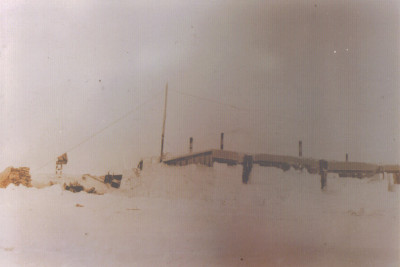 |
| The makeshift accommodation; Baychimo in the distance |
The accommodation after surrounding with blocks of ice |
They were not short of work. They had to search for wood since they didn't want to use Baychimo's coal in case it was needed, they had to cross the ice to the ship every day to check on her condition and even collect ice from a frozen lake five kilometers from their cabin as the ice which surrounded them everywhere didn't provide safe drinking water!
On November 24th, a violent storm forced the men to stay inside their ice-bound igloo for three full days, huddling against one another to keep warm around the gasoline drum they had converted into a stove. But afterwards, when the snowstorm finally died down and they dug themselves out of the snow, imagine their reaction to discover that the Baychimo had completely disappeared. Where she had been three days earlier, there were only huge icebergs!
Nevertheless, life had to go on for the men left stranded in their makeshift accommodation. Christmas came along, then the New Year. Finally, starting on 12th February 1932, Captain Cornwell and the remaining crew were uplifted from their solitary outpost. They travelled by plane and ship to Vancouver, where their service for the Hudson Bay Company officially ended on 8th March. From there, the British members of the crew, including Sydney Cornwell, my grandfather and the other Ayrshire men made their way home by train and ship to Britain. For my grandfather, his great adventure had come to its end at last.
But that certainly wasn't the end of the story. The Baychimo wasn't yet beaten. The storm which had carried her away hadn't sent her to the bottom of the sea. In March 1932, a man travelling by dog-sled from Herschel to Nome saw her firmly embedded in an ice-floe ...........and that was only the first in a long series of sightings. In 1935 and again in 1939, some members of the crew of the tiny, ten ton, schooner Trader boarded her. They discovered navigational instruments and charts, kitchen equipment in the galley, curtains at the porthole windows and books in profusion, including the Times History of the Great War. A veritable Marie Céleste! There were many reports of sightings by Eskimos and ship's captains during the Second World War and she was seen for the last time in 1969, this time not very far from the spot where she had been abandoned so many years before. By that time, she was well established as the "ghost ship of the Arctic"! As for my grandfather, since the day of Baychimo's disappearance in the storm of November 1931, he never saw her again.
It might seem almost unbelievable that any ship, manned by phantoms or men, could survive the incredible force of the Arctic ice for more than three decades, but the Baychimo did just that, and since in fact no-one saw her sink, perhaps she is out there still !.............
Footnote:
Realistically, of course, Baychimo sank long ago to the bottom of the Arctic, but no-one knows where she lies. In 2006, the Alaskan government began a project to locate her, but so far without success. This true story is supported by newspaper cuttings and by an excellent collection of photographs, just a few of which are reproduced on this page. They were handed down to me by my grandfather, who I clearly remember. These photographs show not only the routine work of loading and unloading supplies along the Arctic and Labrador coasts, but also the Bayeskimo during her trials at Ardrossan in 1922, the foundering of that vessel and the rescue of her crew, the departure of the Baychimo from Vancouver in July 1931, and the events of her last voyage.
Most of the photographs were taken by Baychimo second officer Fred W. Berchem - although he does appear himself in some of the photos. Since one of them shows the Baychimo from a rescue plane, it seems that he was among the 22 uplifted from the icy Arctic coast in October 1931.
Fred Berchem had a long career as a ships officer. He retired to the Ardrossan district, where he lived to a grand old age. It was by way of a contact who knew him that I have obtained detailed descriptions for his photograph collection.
These are the Ardrossan men who were part of the sixteen who spent the winter of 1931-32 on the north coast of Alaska:
Harry C. Bolton, chief engineer, of Eglinton Road, Ardrossan.
Finlay Murchie, third engineer, Glasgow Street, Ardrossan (retired to Arran).
Mathew Barr, donkeyman, Princes Place, Ardrossan.
James McEwan and P. McGreer, (seamen).
Alan C. Bolton
Saltcoats.
Revised with minor revisions, October 2020.
References:
 |
"Baychimo, Arctic Ghost Ship", by Anthony Dalton
(ISBN 13: 978-1-894974-14-1 or ISBN 10: 1-894974-14-X) |
"Merchant Princes" by Peter Newman. Penguin. ISBN 0-14-015820-0.
"The Fur-Trade Fleet: Shipwrecks of the Hudson's Bay Company" , Anthony Dalton, ISBN 978-1-926936-09-3. [RECOMMENDED].
"The SS Baychimo: the History and Mystery of the Famous Arctic Ghost Ship", Charles River Editors, ISBN 9781537252087.
"Phantom of the Arctic", by Joan Biggar, in "The Scots Magazine", December 1979.
Many of Fred Berchem's photographs can be viewed in the website of the McCord Museum in Montreal.
(https://www.musee-mccord.qc.ca/fr/ )
Baychimo and other photos
 |
Baychimo prepares to leave Vancouver for her ninth (second last) voyage to the Arctic in July 1930. Captain Sydney Cornwell is the uniformed officer, with his wife on his left. |
| An example of trading operations of the Hudson's Bay Company. Here, supplies from Bayeskimo are being handled at Fort Chimo, at the south end of Ungava Bay. |
 |
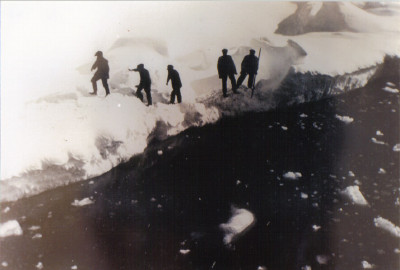 |
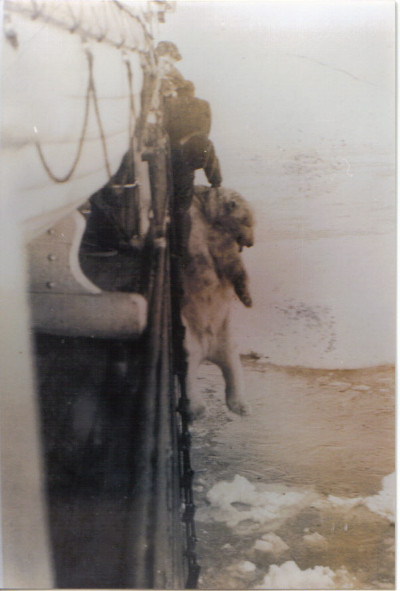 |
| An example of hunting operations from Bayeskimo in 1924 - here, in Baffin Bay, a polar bear is hauled on board. |
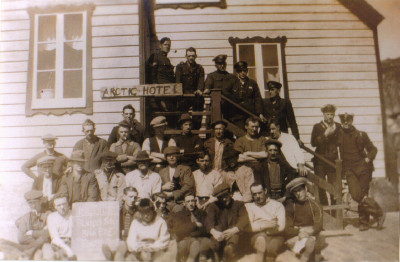 |
Rescued crew and passengers from the foundered Bayeskimo at the Moravian Mission, Port Burwell, Labrador in 1925. On the menu?.....blubber soup, bear pie and eskimo tart ! |
| The doomed Baychimo - firmly embedded in ice near Wainwright in October 1931. |
 |
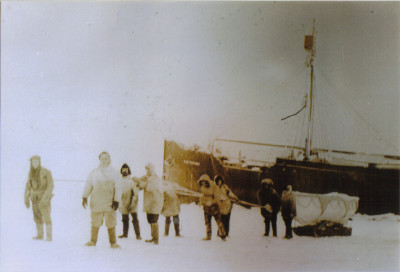 |
Each time the Baychimo was visited, a lifeboat would be taken along in case the ship broke out into ice-free water. |
| My grandfather as I remember him in retirement (1966) |
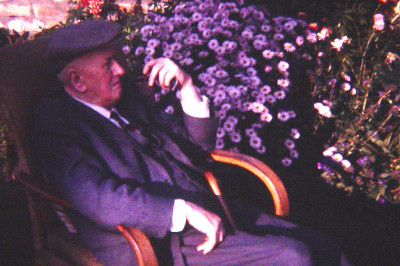 |
TOP